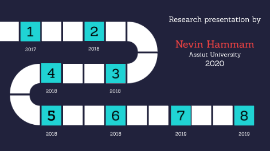Promotion Presentation
Transcript: Research presentation by Nevin Hammam Assiut University 2020 5 Impact of Secondhand Smoking on Disease Activity in Women with Rheumatoid Arthritis 1 2017 Clin Rheumatol, 36 (11), 2415-2420 Nov 2017 Introduction Smoking upregulates the production of proinflammatory cytokines and autoantibodies in RA, and associated with worse outcomes. Passive smoking, called secondhand smoke (SHS), is the inhalation of smoke by persons other than the active smoker. SHS is a risk factor for lung diseases, CVD and RA susceptability, but its association with RA disease activity is unknown. Considering that RA is common in female, and up to 53% of Egyptian women are SHS, our aim was to examine the possible effect of SHS on disease activity in nonsmoking women with RA. Introduction Patients and methods Patients and methods 100 non-smoking RA female patients were included. Patients were grouped according to the non-smoking status into those not exposed, and those considered as secondhand smokers. Patients’ demographic data, disease characteristics, and current medication use were recorded. DAS-ESR28 was assessed and relevant investigations and RF antibodies were performed for the patients . Statistical analysis: Mann–Whitney test was used for differences in quantitative data between not exposed and passive smoker groups, chi-square or Fisher’s exact test for qualitative data differences between groups. Results Results 53 patients were not exposed and 47 of the patients were SHS. No significant difference in clinical parameters, medications use, and RF positivity between non-exposed and passive smokers was detected. DAS-28-ESR was significantly higher in SHS compared to non-exposed (p = 0.02). Conclusions Conclusions There is evidence pointing to the important role of passive smoking on disease activity in RA. Studying the effect of SHS in view of the cytokine could help confirm the relation to the disease pathogenesis. We may adjust disease medication based on smoking status. We can avoid passive smoke exposure in different places by strict regulations. Toll-like receptor 9 in systemic sclerosis patients: relation to modified Rodnan skin score, disease severity, and functional status 2 Clin Rheumatol, 37 (3), 757-763 Mar 2018 2018 Introduction Introduction TLR-9 Intracellular TLR, TLR9, was detected in the lungs of patients with IPF. There is an evidence supporting a pathogenic role of TLR9 in fibrotic skin disease of SSc. Systemic Sclerosis (SSc) SSc is a heterogeneous disease mainly characterized by autoimmunity, vascular damage, and fibrosis that mostly involve the skin and lung. Aim of the study To assess TLR9 expression in CD3-positive T lymphocytes and CD19-positive B lymphocytes in SSc patients and to study their relation to the extent of skin fibrosis, disease characteristics, disease severity as well as the functional status. Patients and methods Patients and methods 55 SSc female patients were recruited. All patients grouped as limited (lcSSc) or diffuse cutaneous (dcSSc) subtypes. 30 age-matched normal females were included as control. Skin thickness was scored according to the mRss method. The severity of involvement of major organs was assessed using the MSS. Scleroderma health assessment questionnaire (SHAQ) was measured. Relevant laboratory investigations were performed to patients. Plain X-rays of the hands and wrists HRCT, and forced vital capacity (FVC) were carried out to all patients. Flow cytometry for TLR9 expression in peripheral blood was measured. Results Results 55 SSc female patients with a mean age of 40.5 ± 9.1 years as well as 30 matched female control of comparable age (38.4 ± 8.6 years; p = 0.28). 21 (38.2%) with dcSSc and 34 (61.8%) with lcSSc. There was a significant increase in the expression of TLR9/CD3 and TLR9/CD19 in the SSc patients compared to that in the control (p < 0.0001). Results Results The TLR9 expression difference in the presence and absence of some clinical manifestations and laboratory manifestations. On multiple linear regression analyses (mRSS, and MSS as the outcomes) and age, disease duration, laboratory investigations, and TLR9/CD3 and TLR9/CD19 as independent factors, only TLR9/CD3 was a significant risk factor of the mRss and MSS (B = 0.43, p = 0.009 and B = 0.33, p = 0.015, respectively). Conclusions Conclusions TLR9, especially TLR9/CD3, is highly expressed in SSc patients particularly those with dcSSc subtype and could form a potential marker for skin fibrosis and disease severity. Disrupting the fibrotic process with inhibitors targeting TLR9 might represent a novel therapeutic approach. Joint Remodeling outcome of serum levels of Dickkopf-1(DKK1),Cartilage Oligomeric Matrix Protein (COMP) and C-telopeptide of type II collagen (CTXII) in Rheumatoid Arthritis 3 Accepted for publication at the Central European Journal Of Immunology, 1-March-2018 2018 Introduction Introduction RA is characterized by chronic proliferation of synovium, cartilage destruction, and periarticular

















